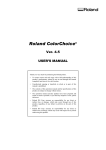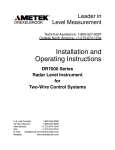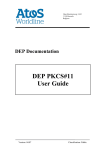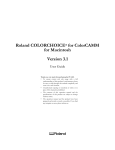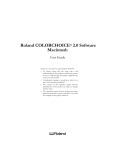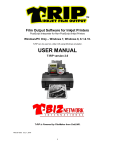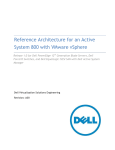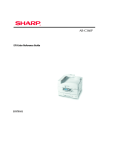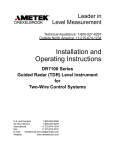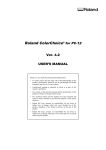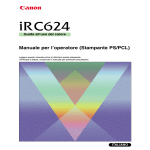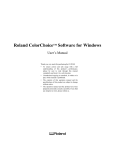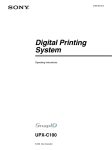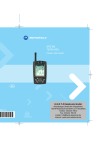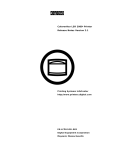Download HP DesignJet 500ps User's Manual
Transcript
HP DesignJet 500PS Table of Contents WELCOME ...................................................................................................................................... 1 SYSTEM REQUIREMENTS MACINTOSH ..................................................................................... 1 SYSTEM REQUIREMENT WINDOWS ........................................................................................... 2 MACINTOSH INSTALLATION........................................................................................................ 3 WINDOWS 95/WINDOWS 98 INSTALLATION .............................................................................. 4 WINDOWS NT INSTALLATION...................................................................................................... 5 WINDOWS 2000 INSTALLATION .................................................................................................. 6 GETTING STARTED ....................................................................................................................... 7 USING THE RIP SOFTWARE............................................................................................................. 7 Printing a Test File.................................................................................................................... 8 Setting up Printer Ports............................................................................................................. 8 Using an ECP Port.................................................................................................................... 8 Using TCP/IP ............................................................................................................................ 8 To add an USB Port to a Windows 98 System......................................................................... 9 To add an USB Port to a Windows 2000 System................................................................... 10 To add an USB Port to a Macintosh ....................................................................................... 10 MENUS .......................................................................................................................................... 11 FILE MENU ................................................................................................................................... 11 Add Job................................................................................................................................... 11 Job Properties......................................................................................................................... 11 Save As................................................................................................................................... 12 Send........................................................................................................................................ 12 Pause...................................................................................................................................... 12 Abort ....................................................................................................................................... 13 Exit/Quit .................................................................................................................................. 13 EDIT MENU................................................................................................................................... 13 Select All ................................................................................................................................. 13 Delete...................................................................................................................................... 13 Preferences ............................................................................................................................ 13 AFTER PRINTING .......................................................................................................................... 13 Units........................................................................................................................................ 13 Simultaneous Ripping and Printing (PC only) ........................................................................ 13 SETUP MENU................................................................................................................................ 14 Change Setup......................................................................................................................... 14 Setup Properties ..................................................................................................................... 14 Test Print................................................................................................................................. 14 VIEW MENU .................................................................................................................................. 14 View RIP Log .......................................................................................................................... 14 Clear RIP Log ......................................................................................................................... 14 PRINTING ...................................................................................................................................... 14 ADDING JOBS TO THE PRINT MONITOR........................................................................................... 14 DELETING JOBS FROM THE PRINT MONITOR ................................................................................... 15 PAUSING AND RESUMING PRINTING ............................................................................................... 15 ABORTING A PRINT JOB ................................................................................................................ 15 PRINTING DIRECTLY FROM AN APPLICATION ................................................................................... 15 PRINTING FROM A CLIENT ON YOUR NETWORK ............................................................................... 16 SETUP PROPERTIES................................................................................................................... 17 THE SETUP PROPERTIES GENERAL TAB ........................................................................................ 17 Manufacturer........................................................................................................................... 17 Model ...................................................................................................................................... 17 Setup Name ............................................................................................................................ 18 Media ...................................................................................................................................... 18 Margin ..................................................................................................................................... 18 PC Ports.................................................................................................................................. 18 File Ports................................................................................................................................. 19 Macintosh Ports ...................................................................................................................... 19 File Ports................................................................................................................................. 19 THE SETUP PROPERTIES PRINT TAB.............................................................................................. 20 Media ...................................................................................................................................... 20 Print Mode............................................................................................................................... 20 Resolution ............................................................................................................................... 21 Driver Options ......................................................................................................................... 21 Perform Color Correction........................................................................................................ 21 ICC input profile ...................................................................................................................... 21 ICC output profile.................................................................................................................... 22 Color Mode ............................................................................................................................. 23 THE COMMUNICATIONS TAB (W INDOWS ONLY) .............................................................................. 23 THE COLOR ADJUST TAB .............................................................................................................. 23 JOB PROPERTIES ....................................................................................................................... 24 JOB PROPERTIES GENERAL TAB.................................................................................................... 24 Media ...................................................................................................................................... 24 Size ......................................................................................................................................... 24 Copies..................................................................................................................................... 25 Layout ..................................................................................................................................... 25 JOB PROPERTIES PRINT TAB ......................................................................................................... 26 THE COLOR TAB ........................................................................................................................... 26 ADVANCED PRINTING PROCEDURES (WINDOWS) ................................................................ 27 ADVANCED PRINTING PROCEDURES (MACINTOSH) ............................................................ 30 Welcome Welcome to the User Guide for the HP DesignJet 500PS RIP Software. We recommend that you read and understand this document, and if necessary print it for future reference. To print this document from Adobe Acrobat Reader, select File>Print from the menu bar. This User Guide is copied to your computer as part of the installation. If you need to locate it for future reference, it is stored in the HP DesignJet 500PS directory. This document contains instructions for the Macintosh and Windows 95/98, Windows 2000 and Windows NT. System Requirements Macintosh The following table lists the minimum and recommended system setup to run the RIP Software. System requirements vary according to the size of the files to be printed, the output device used, and other variables. Your particular setup and intended use of the software determine what hardware and software setup you need to get the most out of the RIP Software. If you are working with relatively small files, the minimum setup may be sufficient. Similarly, if you are working with large files, you should consider the recommended setup. Consult your dealer for advice when choosing a system. Minimum Recommended PowerPC 166 G3 or G4 300 MHz or faster Operating System Mac OS 8.5.1, 8.6 or 9.x Mac OS 9.x RAM *64 MB RAM *128 MB RAM or greater Hard Drive space available 500 MB Free Disk Space 1 GB Free Disk Space or larger Video 800 x 600 screen resolution with 16 bit color (thousands of colors) 800 x 600 screen resolution with 16 bit color (thousands of colors) Other CD-ROM Drive CD-ROM Drive USB Port for security device USB Port for security device Appearance Manager and ColorSync installed Appearance Manager and ColorSync installed 10 BASE-T 100 BASE-TX Network * Requires virtual memory enabled. Set to 196-MB minimum. 1 System Requirement Windows The following table lists the minimum and recommended system setup to run the RIP Software. System requirements vary according to the size of the files to be scanned and printed, the output device used, and other variables. Your particular setup and intended use of the software determine what hardware and software setup you need to get the most out of the RIP Software. If you are working with relatively small files, the minimum setup may be sufficient. Similarly, if you are working with large files, you should consider the recommended setup. Consult your dealer for advice when choosing a system. Minimum Recommended Processor 200-MHz Pentium II 350-MHz Pentium II or faster RAM 64-MB (128MB with RIP) 128-MB RAM (196MB with RIP) or greater Hard Drive space available 500 MB Free Disk Space 1 GB Disk Space or larger System Windows 95/98 /2000/*NT Windows 98/2000/*NT Video 600/800 resolution with 16 bit color 600/800 resolution with 16 bit color Other CD-ROM Drive CD-ROM Drive LPT LPT 10-BASE-T 100 BASE-TX Network * Windows NT requires Internet Explorer 4 or greater. 2 Macintosh Installation This section describes the kind of system setup you need to run the RIP Software and how to install the RIP software. When you are ready to begin using the RIP Software, follow the steps in appropriate section, this will enable you to install the RIP Software properly. Installing the RIP Software on a Macintosh System 1. 2. 3. 4. 5. Insert the Installation CD into your CD-ROM drive. Double-click the Installer icon. Select the Installer language from the Universal Installer window. Click OK. The system displays the Installations Options window. Select the language of the product you would like from the Language dropdown box. 6. Click OK. 7. Accept the default selection of Easy Install and specify the location to which to install the software. Click Install when you are finished. Please launch Adobe PostScript Driver Installer. Installing AdobePS Driver 1. 2. 3. 4. 5. 6. 7. 8. Locate the Adobe PostScript driver folder. Select the language folder you would like to install. Double-Click on AdobePS Installer icon. After reading the License agreement click on Accept to continue. Select the Install location from the Install Location drop-down box. Click Install. Click Quit. Reboot your computer. Setting up the RIP Software 1. 2. 3. 4. Double-Click on HP DesignJet 500PS. Select a printer model. Click Next. Select the port type you would like to use. You may choose from USB, AppleTalk or TCP/IP port. AppleTalk and TCIP ports are available if you have the optional HP JetDirect 610 LAN card installed. 5. Click OK. Creating a Desktop Printer 1. 2. 3. 4. Open the Chooser from the Apple menu and highlight AdobePS. Locate your PostScript printer Click Create. Select the HP500PPD. The system gives you the option to select HP DesignJet 500PS or HP DesignJet 500PS 42. 5. Click OK. 6. Select Standard Memory. 7. Click OK. Uninstalling the RIP Software from a Macintosh System 1. 2. 3. 4. Quit the RIP Software, if it is still open. Drag the RIP Software Folder into the Trash. Open the System folder From the Preferences folder, drag the files named ‘the HP DesignJet 500PS Preferences’ and ‘HP DesignJet 500PS Prefs’ the Trash. 3 5. 6. 7. 8. Locate and open the ‘Extensions’ folder. Drag the spooler file into the Trash. The Spooler file is named according to your printer, and appears as ‘Am_<printer name>’, depending on which printer you installed. From the ‘Printer Descriptions’ folder, located within the ‘Extensions’ folder, drag the PPD files, named according to your output device, into the Trash. Restart your computer. Hold down the Option key while you empty the Trash. The software is now uninstalled. Windows 95/Windows 98 Installation 1. Insert the Installation CD into your CD-ROM drive. 2. From the CD Setup window, select the language of the installer you would like. 3. Click Next. The Software to Install window displays. 4. Select the language of the software you would like. 5. Click Next. The system displays the License agreement window. 6. After reading the License agreement, click Yes to accept. The Welcome window displays. 7. Click Next. The select Program Folder displays. 8. Select the folder you would like HP DesignJet 500PS to display in. 9. Click Next. The Destination Location window displays. 10. Select the destination by clicking on Browse or except the default location. 11. Click Next. Note: If you currently have HP DesignJet 500PS on your system the Clear Preferences window displays. Click Yes to delete preference settings on your system. Click not to retain your old preference settings. 12. Click OK to restart your computer. Setting up the RIP Software 1. Select a printer model. 2. Click Next. 3. Select the port type you would like to use. You may choose LPT or TCIP if you have the HP JetDirect 610 network CARD installed. If you choose TCPIP you will be asked to enter the IP address of the printer. Find it in the front panel of the machine 4. Click Finished. The system will reboot your computer. Installing AdobePS Driver 1. After reading the License agreement, click Yes to accept. The AdobePS Postscript printer driver setup window displays. 2. Click Next. The Install Setup Program displays. 3. Click Next. The Install Printer Window displays. 4. Select Local Printer, then click Next. 4 5. Select PPD’s. PPD’s can be found on your HP DesignJet 500PS installation CD. 6. Click Next. The Select Port Window displays. 7. Select your Port. The Get Shared Information window displays. 8. Select Not Shared if software is save on your local drive. Select Shared if your software is running on a network. 9. Click Next. Windows NT Installation This section describes how to install the software on computers running Windows NT. The logon with which the software is installed must have Administrator privileges. These instruction assume that you have the HP DesignJet 500PS Setup CD in your CDROM drive, and that you have read the recommendations in the Advisor (the series of screens that appeared when you selected your language). Installing the RIP Software on a Windows NT System 1. Insert the Installation CD into your CD-ROM drive. 2. From the CD Setup window, select the language of the installer you would like. 3. Click Next. The Software to Install window displays. 4. Select the language of the software you would like. 5. Click Next. The system displays the License agreement window. 6. After reading the License agreement, Click Yes to accept. The Welcome window displays. 7. Click Next. The select Program Folder displays. 8. Select the folder you would like HP DesignJet 500PS to display in. 9. Click Next. The Destination Location window displays. 10. Select the destination by clicking on Browse or except the default location. 11. Click Next. 12. Note: If you currently have HP DesignJet 500PS on your system the Clear Preferences window displays. Click Yes to delete preference settings on your system. Click not to retain your old preference settings. 13. Click OK to restart your computer. Setting up the RIP Software 1. Select a printer model. 2. Click Next. 3. Select the port type you would like to use. You may a choose LTP or TCIP if you have the DesignJet network port option installed. 4. Click Finished. The system will reboot your computer. 5 Installing AdobePS Driver 5.1 1. After reading the License agreement, click Yes to accept. The AdobePS Postscript printer driver setup window displays. 2. Click Next. The Install Setup Program displays. 3. Click Next. The Install Printer Window displays. 4. Select Local Printer, then click Next. 5. Select PPD’s. PPD’s can be found on your HP DesignJet 500 PS installation CD. 6. Click Next. The Select Port Window displays. The Get Shared Information window displays. 7. Select Not Shared if software is save on your local drive. Select Shared if software is save on a network. 8. Click Next. 9. Select LPT1 for your local port selection. 10. Select Browse to find your printer model. The printer model can be found in the DJ500PS folder. 11. Click Next. The Printer Name widows displays. 12. Select No for your default printer. 13. Select No to Test page. 14. Click Next. 15. Click Install. Windows 2000 Installation 1. Insert the Installation CD into your CD-ROM drive. 2. From the CD Setup window, select the language of the installer you would like. 3. Click Next. The Software to Install window displays. 4. Select the language of the software you would like. 5. Click Next. The system displays the License agreement window. 6. After reading the License agreement, Click Yes to accept. The Welcome window displays. 7. Click Next. The select Program Folder displays. 8. Select the folder you would like HP DesignJet 500PS to display in. 9. Click Next. The Destination Location window displays. 10. Select the destination by clicking on Browse or except the default location. 11. Click OK. The system will reboot your computer. Setting up the RIP Software 1. Select a printer model. 2. Select a port. 6 3. Click Next. The Add Setup window displays. 4. Click Finish. Uninstalling the RIP Software from a Windows System 1. Exit the RIP Software and all programs. 2. From the Start Menu, Select Settings and then click on the Control Panel. 3. Select Add/Remove Programs. 4. Select the RIP Software. 5. Click OK. Getting Started Windows The RIP Software is automatically launched each time you start your computer. However, you will need to view the Print Monitor in order to work with it. To view the Print Monitor, double click on the RIP Software icon located in the lower right corner of your computer’s monitor. Macintosh The RIP Software is automatically launched each time you print or you may double-click the RIP Software icon. The RIP software will open the print monitor window. Using the RIP Software You can control every facet of job management from the Print Monitor. The Print Monitor is essentially a queue, listing all the files that are waiting to be printed. Jobs appear in the queue in the order that they were received. For each job, the following information is displayed: § Job Name—the name of the file, including any extensions. § Status—the current status of the job, either Holding, RIPing (the process of converting images to a series of minute dots so that they can be printed), or Printing. 7 § Copies—the number of copies to be printed. § Media—the media on which the job will be printed. § File Type—the file type of the selected job. Note: For Windows to quit the RIP Software program, right click on the icon, and then select Exit from the menu that appears. Once you have quit the software you must restart your computer to use the RIPsoftware. Printing a Test File To insure that your software is properly installed and that a connection to the printer is established, it is recommended that you make a test print. When you do this a small test file is sent to the Print Monitor and then printed. Once you’ve successfully printed a test file, be sure to read the rest of this document to learn about other features To Make a Test Print § From the Setup Menu select Test Print. A small PostScript test file is sent to the Print Monitor and then printed. Setting up Printer Ports After the Software RIP has been installed and your printer is ready, there remains one important link—sending the ‘print’ information from the software to the printer. There are three ways to do this: § Using an ECP Port § Using TCP/IP § Using USB Port Using an ECP Port You can output jobs to a printer connected directly to one of your computer’s parallel ports. To Use an ECP Port 1. Open the RIP Software Print Monitor by double-clicking on its icon in the lower right corner of your screen. 2. From the Print menu select Setup Properties. 3. Click on the General tab. 4. In the ‘Port’ list, select a parallel port (usually called LPT1 or LPT2). 5. Click Apply 6. Click OK. Using TCP/IP Use TCP/IP Printing protocol to output to a network device. To use TCP/IP you must have the HP JetDirect 610 network card option installed. For additional information on the HP JetDirect 610-network card please speak with your service representative. 8 To Use a TCP/IP Port 1. From the Setup menu select Setup Properties. 2. From the General Tab select TCP/IP as your port. The Communication window displays. Note: The IP address can be found in the control panel of your HP DesignJet 500PS printer. 3. Click OK. To add an USB Port to a Windows 98 System Adding your new driver is a four-step process, first install the HP DesignJet500 PS software. Next the USB driver software must be installed onto your computer this can be found on your installation CD. You must then add a generic printer that will be associated to the USB driver. Finally you will edit preferences to associate the USB driver to the generic printer you have installed. Please note Windows NT does not support USB. To Install HP DesignJet 500PS USB driver Software 1. Insert the Installation CD into your CD-ROM drive. 2. Install the HP DesignJet 500PS software. 3. Plug your USB cable into the back of your PC then plug the USB cable into your printer. The Add New Hardware Wizard displays. 4. Click Next. 5. Select Search for the best driver for your device (Recommended). 6. Click Next. 7. Select specify a location. 8. Click Browse to find the location of your Windows 98 USB driver. The USB driver may be found on your Installation disk in the WIN98USB folder. 9. Click OK. The system displays a message stating Windows is now ready to install the best driver for this device. 10. Click Next. The system displays a message stating Windows has finished installing the software that your new hardware device requires. 11. Click Finished. To Add a Generic Printer 1. 2. 3. 4. 5. 6. 7. 8. 9. 10. 11. 12. 13. From the Start Button select Settings and then Printers. Click Add Printer. The Add Printer Wizard displays. Click Next. Select Local printer. Click Next. The system will request that you select a manufacturer and a printer model. Select Generic as the manufacturer. Select Generic/Text Only as the Printer model. Select USB/DesignJet 500PS as the name of your port. Click Next. The system asks if you would like to use this printer as your default printer. Click No. Click Next. The system asks if you would like to print a test page. Click No. Click Finish. 9 Note: If the cab file driver12.cab was not installed during your initial installation of Windows 98 the system will request that you insert your Windows 98 Installation CD. This file may be found in the WIN98 directory folder. Locate the cab file and then click OK. To associate an USB driver to a Generic Printer. 1. 2. 3. 4. Open the HP DesignJet 500PS software. From the Edit menu, select Preferences. From the Generic Driver field drop-down list, select Generic/Text Only. Click OK. The USB port is now completely installed. To select the USB Port 1. 2. 3. 4. 5. 6. Open the HP DesignJet 500PS software. From the Setup menu, select Setup Properties. Select the General tab. From Ports drop-down list, select USB/DesignJet. Click Apply. Click OK. To add an USB Port to a Windows 2000 System Adding your new driver is a three-step process, first install the HP DesignJet500 PS software. Next the USB driver software must be installed onto your computer this can be found on your installation CD. Finally, select the USB/DesignJet port from Setup. Please note Windows NT does not support USB. 1. Install the HP DesignJet 500PS software. 2. Plug your USB cable into the back of your PC then plug the USB cable into your printer. The Found New Hardware Wizard displays. 3. Select Display a list of the known drivers for this device so that I can choose a specific driver. 4. Click Next. 5. Click on the Printers Icon. 6. Click Next. The Add Printer Wizard displays. 7. Select Generic as your manufacture. 8. Select Generic/Text Only as your Printer type. 9. Click Next. To select the USB Port 1. 2. 3. 4. 5. 6. Open the HP DesignJet 500PS software. From the Setup menu, select Setup Properties. Select the General tab. From Ports drop-down list, select USB/DesignJet. Click Apply. Click OK. To add an USB Port to a Macintosh 1. Install the HP DesignJet 500PS software. 2. Plug your USB cable into the back of your Macintosh then plug the USB cable into your printer. 10 To select the USB Port 1. 2. 3. 4. 5. 6. Open the HP DesignJet 500PS software. From the Setup menu, select Setup Properties. Select the General tab. From Ports drop-down list, select USB/DesignJet. Click Apply. Click OK. Menus You may access a number of the RIP Software’s functions using the menus at the top of the main window. File Menu The File menu allows the user to add a job, save a job as a different format, send, pause, or abort a job or stop the process by exiting. The following chart defines each of these options: Add Job The Add a Job command allows you to add a job directly to the Print Monitor. To Add a Job 1. From the File menu select Add Job. The Add Job dialog box displays. 2. From the Add Job Dialog, select the path of the job you would like to add. 3. Click Open. The job is added to the printer queue. Job Properties Job Properties can be accessed from within the RIP Software and are settings associated with a particular job. The Job Properties come from either the Printing Properties set in client, or the Setup Properties set in the RIP Software’s Server. To change the Job Properties, you must select the job in the printing queue and then select Job Properties from the File menu. Within Job Properties you may preview the job by selecting page preview, layout preview or no preview (Macintosh only). Page preview displays the image of the job. Layout preview displays the job relative to the output media. (See the Job Properties General Tab section for additional details). 11 Save As The Save As command allows you to save an image into different file formats. Once a job has been printed, you may want to save the RIPed file so that you can reprint it without having to RIP the file again. Saving a file as Native format, with a .PRT extension, allows you to save RIPed files for reprinting. To Save a Job into a Different Format 1. Click on the job you would like to save into a different format. 2. From the File Menu select Save As. 3. From the Save as type drop-down box, select the file type you would like to save the document as. 4. Click Save. Send Once jobs are in the Print Monitor, you can select individual jobs or groups of jobs for printing. When selecting a group of jobs, they are printed in the order that they appear in the queue. To Send a Job to Print 1. Click on the job or jobs you would like to print. 2. From the File Menu select Send. Pause When printing a job, the software begins RIPing the file. RIP, which stands for Raster Image Processor, is a process that converts the selected file into a series of dots that are used to reproduce the file on the selected media. RIPing involves a complex algorithmic process that requires a significant portion of your computer’s processing capacity. Larger files, in terms of MB, take longer to RIP than smaller files. The nature of the RIP process makes it impossible to pause and restart. For this reason, the Pause button is dimmed to prevent you from pausing a job during the RIP process. However, once a job is done RIPing and has begun printing, you can use the Pause button to stop and restart the printing process as often as desired. To Pause a Print Job 1. Click on the job you would like to pause. 2. From the File Menu select Pause. To resume a printing Job § Click on the paused print job. Click the Pause button again (Resume) to resume the printing process. 12 Abort Although a job cannot be paused during the RIP process, the job can be aborted. After aborting a job, all RIP’ed information is lost and the process must start again. To Abort a Print Job 1. Click on the job you would like to abort. 2. From the File Menu select Abort. Exit/Quit The exit command ends the program and closes the Print Monitor window. To Exit or Quit the Program § From the File menu select Exit/Quit. Edit Menu The Edit menu allows the user to select all files, delete a file, and change preferences. Select All The Select All command selects all files in the print queue. Delete The Delete command allows deletion of specifically selected files. Preferences Preferences allow access to default settings, including what to do with files after printing and to specify the units of measurement. These preferences, in conjunction with Setup Properties, form the default print settings. Default print settings are applied to any job(s) that is added using the Add Job command. Settings in Preferences are overridden when printing from a design application (ex. Adobe Illustrator). After Printing Tells the Print Monitor what to do with the job after it has finished printing, either Hold or Delete. Units Select the desired unit of measurement. Simultaneous Ripping and Printing (PC only) The system starts printing before ripping is finished. 13 Setup Menu A setup consists of a device and it’s associated properties. Items in the Setup menu apply to the selected setup. Select a setup by clicking on the setup icon in the setup area of the main window. Change Setup The Change Setup command allows you to access and follow the same wizarddriven steps contained in the original installation. Switch back to the original setup using the Change Setup command again. Setup Properties Setup Properties displays the default print settings for your printer. To View Setup Properties § From the Setup menu select Setup Properties. The Setup Properties dialog opens with the General tab selected (See Properties Tabs). Test Print The Test Print command allows you to ensure that your software is properly installed and that the connection to the printer is established. To Print a Test § From the Setup Menu select Test Print. A small PostScript test file is sent to the Print Monitor and then printed. View Menu The View Menu allows the user to show or hide the command iconToolbar, view a RIP Log or Clear a RIP log. To Show or Hide the Toolbar § From the View menu Select Toolbar to show the Toolbar select Toolbar again the hide the Toolbar. View RIP Log The View RIP log displays a text file containing a record of the RIP processes. Clear RIP Log The Clear RIP log purges information from the RIP log. Printing Adding Jobs to the Print Monitor The Jobs Management area of the RIP Software allows you to add jobs to the Print Monitor. 14 To Add a Job 1. From the File menu select Add Job. 2. Select the job you would like to add then click on Open. 3. To send a job to the printer, select the job from the Print Monitor’s queue and then choose Print from the File menu. Deleting Jobs from the Print Monitor A job may be deleted from the job list before or after it is cut or printed. To Delete a Job 1. Select the job or jobs that you want to delete by selecting them in the Print Monitor’s queue. 2. From the File menu choose Delete. Pausing and Resuming Printing When printing a job, the software begins RIPing the file. RIP, which stands for Raster Image Processor, is a process that converts the selected file into a series of dots that are used to reproduce the file on the selected media. RIPing involves a complex algorithmic process that requires a significant portion of your computer’s processing capacity. Larger files, in terms of MB, take longer to RIP than smaller files. The nature of the RIP process makes it impossible to pause and restart. For this reason, the Pause button is dimmed to prevent you from pausing a job during the RIP process. However, once a job is done RIPing and has begun printing, you can use the Pause button to stop and restart the printing process as often as desired. To Pause or Resume a Job 1. Select the job to pause by selecting it in the RIP Software’s Print Monitor window. 2. Click the Pause icon. 3. Click the Pause button again (Resume) to resume the printing process. Aborting a Print Job Although a job cannot be paused during the RIP process, the job can be aborted. After aborting a job, all RIP’ed information is lost and the process must start again. To Abort a Print Job 1. Select the job to abort by selecting it in the RIP Software’s Print Monitor window. 2. From the File menu choose Abort a Job or click the icon Saving a Job Printing Directly from an Application Once you have specified setup properties, you can print directly from your application without adjusting any values from the Print Monitor menus. 15 Most applications have Page setup and Print Command options within the File Menu. Make sure you select the correct printer setup that you have installed. Please consult your DTP application for more details on the print command. To Setup Driver Properties 1. From the File menu select Print. 2. Select HP DesignJet500 PS. 3. Click the Properties button. 4. Select the Advanced tab. 5. Select Printer Features. The system displays the following printer features: After Spooling, After Output, Bitmap rendering intent, Vector rendering intent, ICC output profile and Print Quality which may be customized. See The Setup Properties Print section of this manual for additional information. Printing from a Client on your Network If you have a network of PCs and have completed the additional setup instructions for network printing, you can print from any client on your network. When you do this, jobs arrive in the ‘Hot’ folder of the server and are processed like any other job. There are two ways to send jobs to the server for processing: § Dragging the file directly into the server’s shared ‘Hot’ folder OR § Using the design application’s Print to File function and selecting the server’s ‘Hot’ folder as your destination 16 Setup Properties The Setup Properties window can be accessed from within the RIP Software Server and are settings used to process jobs that do not have properties of their own associated with them. Setup Properties contain the defaults of the RIP software and printer property settings. If a job is placed in an output device’s Hot Folder, and it does not contain any properties, then the settings from the Setup Properties will be applied to the job. To Access Setup Properties. § From the Setup menu, select Setup Properties. The Setup Properties window displays. The Setup Properties General Tab The General tab displays standard Windows printer settings associated with printer port selection and media size. Manufacturer Manufacturer displays the manufacturer of your printer. Model Model displays the name and model of your printer. 17 Setup Name The setup name displays the name of your printer. Media Name Displays the name of the media type. Width/Height Accepts direct entry of the job’s width or height. When one aspect is altered the other is automatically updated to keep the job proportionally correct. Max Height Indicates the maximum height that can be printed. Margin Displays the margins from the edges of the media. Margins are the areas on the edges of the media where nothing will print. PC Ports Selects the port to which the printer is connected. Only change the Port selection if you physically change the port to which your printer is connected. Ports may be found on the General within Windows. Parallel Ports (LPT ports) (PC Only) Parallel Ports are probably the most common method of sending data to output devices. Devices connected to a Parallel Port are connected directly to the RIP Software Server computer with a Parallel cable. There are several print modes available to Parallel Ports. The most common Parallel Port modes are Standard and ECP. The mode defines the method of communication between your computer and your output device. Typically, you set the communication mode for the Parallel Port in your computer BIOS. To find out how to access your computer's BIOS and change the port setting, consult the documentation that came with your computer. Note - Sharing the Parallel Port by plugging your output device in behind your RIP Software Server key may cause slower output. We recommend using separate Parallel Ports for your RIP Software Server key and your output device. Standard or Centronics Mode This is the traditional uni-directional communication. This mode should work with all output devices, though print speed may be reduced because of its slow transfer rate. ECP Mode (Extended Capability Port) is a fast bi-directional communication mode that is supported by many newer output devices. ECP offers a fast data transfer rate to support faster printing and higher DPI printing. To take advantage of ECP communications you must have an output device that supports ECP mode, and a Parallel Port on the computer that supports ECP mode. 18 Note - To enable ECP mode you may need to turn off the “Use standard LPT driver checkbox in the communications tab of the Setup Properties inside of application. File Ports The File Port behaves like a save to file option. Instead of sending data out through a port on your computer, the File Port option will write the data to a file and save it to a specified location. Use the File Port to send data to printers that use their own Hot Folders, to transfer files to another computer, or to troubleshoot a specific output device. Macintosh Ports USB The system displays a list of printers connected to your USB port. AppleTalk The system displays a list of HP DesignJet 500PS printers connected in the network. This option is available if your printer is installed with the HP JetDirect 610-network card. TCIP/IP User must enter an IP address, which maybe obtained from your printer. This option is available if your printer is installed with the JetDirect 610-network card. File Ports The File Port behaves like a save to file option. Instead of sending data out through a port on your computer, the File Port option will write the data to a file and save it to a specified location. Use the File Port to send data to printers that use their own Hot Folders, to transfer files to another computer, or to troubleshoot a specific output device. 19 The Setup Properties Print Tab Media This option allows the user to select the media type output will be printed on. ICC profiles will automatically update to the correct profile. Print Mode This option allows you to select the print quality speed for output. Best IQ Use this setting when you are printing to high-cost media such as "white film" or one of the glossy media types, this option gives the highest print quality for image and graphics printing. Normal IQ Use this setting to produce excellent print quality on plain or special paper, printing with this option is faster than Best Mode for image and graphics printing. Fast IQ Use this setting for draft copies or when speed is more important than print quality. Printing with this option is the fastest for image and graphics printing. Best CAD (Text, precise Illustrations, and line drawings) Use this setting when you are printing to high-cost media such as glossy media types, this option gives the highest print quality for CAD printing. Normal CAD Use this setting to produce excellent print quality on plain or special paper, printing with this option is faster than Best Mode CAD printing. 20 Fast CAD Use this setting for draft copies or when speed is more important than print quality, printing with this option is the fastest for CAD printing. Resolution You may choose between maximum and normal resolution provided that the print mode supports it. Driver Options Clicking this button launches the Driver Options dialog. Printer Color Calibrations This is feature allows printer to do color calibrations between the RIP software and the printer. Apply Color Calibration Data If this option is checked the system will use the data stored to print. If this option is not check the system uses default settings. When this option appears gray the system has no data store, this may occur the first time the printer is used or if data is deleted by the user. Get Color Calibration Data Retrieves the calibration parameters from the printer. If this option appears gray the port currently being used does not allow for data retrieval. Status Window Displays system messages. Cut Media After Printing Cuts the media after the print is complete. If a drying time has been set, the media will be cut after the dry time is finished. Perform Color Correction Checking this setting activates the color correction settings. If this setting is not checked, incoming jobs are assumed to already have color correction. ICC input profile Input profiles are used to convert the image into a neutral color space. Once the image is in a neutral color space, then the output profile is used to convert the image into the color space of the output device. To add an ICC input profile from another source, click the Add button. Three types of ICC input profiles can be specified: CMYK ICC input profile The CMYK input profile defines all elements of a job that are in CMYK color mode. If your job is in the RGB color mode, then you should leave the CMYK input profile set to the Generic setting. If your file contains images in both the CMYK and the RGB mode, then the CMYK input profile will be applied to the CMYK images and the RGB input profile will be applied to the RGB images. If your image is in the CMYK color mode, then your file was previously separated for output to a specific output device. Whenever possible, use the profile for the 21 device to which the elements were separated, as the CMYK input profile. If you do not have the profile, try similar profiles or profiles for common ink sets (such as CMYK SWOP). RGB ICC input profile The RGB ICC input profile defines the RGB source for all of your RGB files. An RGB input profile can be for either a monitor or a scanner. If you scanned your file directly to a folder, it is best to select your scanner calibration as the RGB input profile. If you have done any on- screen color correction, you should select your monitor as the RGB input profile. If you do not have a monitor profile, it is generally safe to select the Generic ICC input profile. The Generic profile assumes that you have a Trinitron monitor with a temperature of D65 and a gamma of 1.8. Selecting the correct RGB source will insure that the RGB data you see on-screen will be matched to the output printer. Gray ICC input profile The Gray ICC input profile defines the Grayscale source for all of your grayscale files. This may refer to either a grayscale scanner or a grayscale monitor. ICC output profile ICC output profile- Output profiles are created for the combination of ink and media, and resolution and dither type of your output device. When selecting a profile, be sure to select the profile that matches these criteria. For output devices that print at multiple resolutions, RIP Software provides profiles for each of those resolutions. Choosing a profile with the wrong resolution will severely effect the output. Profiles with different dither types will not greatly effect your output; however, they may cause slight shifts in color. To add an ICC output profile from another source, click the Add button. Click the Info button for information pertaining to the ICC output profile that has been chosen under Profile. Bitmap/Vector Rendering Intent Rendering intent- before a file can be RIPed, its ICC profile must be selected so that the RGB color space of the file can be mapped or translated into to CMYK colorspace. How the colorspace gets mapped is determined by the color rendering intent that you select. The rendering intent selected in the Bitmap rendering field will be applied to bitmap images in your job file. The rendering intent selected in the Vector rendering intent field will be applied to vector images in your file. Choose from one of the following rendering intents: Perceptual This intent is best for photographic images. Colors outside of the output device's gamut are either clipped or compressed to fit the output device’s color space Relative Colorimetric This intent is best for images, such as logos, where the original image needs to match the output. Colors that fall outside of the output device's gamut are clipped. This method may reduce the total number of colors available. The white point of Relative Colorimetric is always zero. Saturation This intent is best for graphic images, such as vector art, where vivid colors are more important than true color matching. Colors outside of the output device's gamut are mapped to colors at the extent of the gamut's saturation. Color's that fall within the gamut of the output device are 22 shifted closer to the gamut's saturation extent. This rendering intent may also be used to boost colors within a photographic image. Absolute Colorimetric This intent is similar to Relative Colorimetric, but has a different white point value. Absolute Colorimetric represents colors relative to a fixed white point value of D50. For example, the white of paper A will be simulated when printing on paper B. This intent is best for color matching when printing Pantone colors. Color Mode Allows the user to select CMYK Color or Gray scale printing. The Communications Tab (Windows Only) The options available in the communications tab will change according to what port you have selected. The Color Adjust Tab The Color tab displays settings associated with the color quality of the image. Using the sliders on the tab, you can adjust the image quality. The sliders that appear vary, depending on which color mode is selected on the Print tab. In all modes, you can adjust the overall image contrast using the Contrast slider. 23 Job Properties Job Properties can be accessed from within the RIP Software and are settings associated with a particular job. The Job Properties come from either the Printing Properties set in client, or the Setup Properties set in RIP Software Server. To change the Job Properties, select Job Properties from the File menu. Within Job Properties you may preview the job by selecting page preview, layout preview or no preview (Macintosh only). Page preview displays the image of the job. Layout preview displays the job relative to the output media. Job Properties General Tab Media Shows the size of the currently selected media. You may change the size by selecting another media size from the drop down list. Size Scale You may change the size of the output here. In most cases, a job’s size should be controlled from within the application in which it was created to prevent unexpected results. 24 Fit to Media Increases or decreases the job proportionally to fit the maximum of the output device. Width/Height Accepts direct entry of the job’s width or height. When one aspect is altered the other is automatically updated to keep the job proportionally correct. Copies Number You may change the number of copies of the job to be output. Spacing You may change the spacing between the copies that are output. Output at origin- Select this option to output the job at the machine’s origin on the edge of the media. Layout Output at origin Select this option to output the job at the machine’s origin on the edge of the media. Output in center Select this option to output a job in the center of the media. Output in the center of media Select this option to output the job in the center of a sheet of media. Offset W Select this option to set an offset distance from the machine’s origin. Offset H Select this option to set an offset from the leading edge of the media. Horizontal Mirror Click to mirror the job horizontally. Rotate Click to rotate the job 90 degrees. After Output Choose what to do with the job after it is done processing, either Hold or Delete. 25 Job Properties Print Tab For more information on Print Tab options, refer to the Print Tab section in Setup Properties section of this manual. The Color Tab For more information on Color Tab options, refer to the Color Tab section in the Setup Properties section of this manual. 26 Advanced Printing Procedures (Windows) If your program is not listed, refer to a section on a similar program. CorelDRAW 8 1. From the HP DesignJet 500PS Print Monitor click Setup>Setup Properties. Then click the Print tab. 2. Make sure the Perform Color Correction checkbox has a check in it. 3. In the ICC input profile area, select appropriate CMYK and RGB profiles. If you know which profiles your application is using, select that profile. If you don’t, use the default setting. 4. For the ICC output profile, select the appropriate ink/media combination. Also select a rendering intent to use. Click the Info button to see a full description of the selected profile. 5. Click OK in the Setup Properties dialog box. 6. In CorelDRAW, select Print Setup. Select your printer from the ‘Name’ field. 7. Click the Properties button. Choose a page size from the Paper field or select Custom Page for a custom page size. 8. If you choose a Custom Page, click on the Custom button and enter the custom size in the paper width and height fields. The paper size should match the size entered in Corel. 9. Click OK in the Printer Properties dialog. 10. Click OK in the Print Setup dialog. 11. Click File>Print. Then select your printer from the Name menu. 12. Select the PostScript tab and then select PostScript3 and uncheck Output Bitmaps in RGB. 13. Select the Miscellaneous tab and uncheck Use Color Profile. 14. Click Print. Illustrator 7 The Kodak Color Management System must be installed to output successfully from Illustrator 7 to HP DesignJet 500PS Software. 1. From the HP DesignJet 500PS Print Monitor click Setup>Setup Properties. Then click the Print tab. 2. Make sure the Perform Color Correction check box has a check in it. 3. Click OK in the Setup Properties dialog. 4. In Illustrator, go to File>Document Setup. 5. Select ‘Use printers default screen.’ 6. Select ‘Use Print Setup’. 7. Click the Print Setup button. Print Setup screen appears. 8. Select your printer in the Name field. 9. Click the Properties button. 27 10. Choose a paper size from the ‘Paper’ field or select a Custom page for a custom page size. 11. If you choose a custom page size, you may enter the custom size by clicking the Custom button and entering the width and height. 12. If you choose custom page, click OK to Custom Defined Size dialog. 13. Click OK in the Properties dialog. 14. Click OK in the Print Setup dialog. 15. Click OK in the Document Setup dialog. 16. If you want your monitor to soft-proof CMYK output, go to File>Color Settings and check ‘Simulate print colors on display’. 17. Go to File>Print. 18. If not dimmed, set Output to Composite. 19. Set PostScript to Level 2. 20. Check Force Fonts to Download. 21. Click OK to print. PageMaker 6.5 These directions assume that you have Kodak ICC Color Management installed. Before starting PageMaker, copy your printers’ PPD files to PM65\RSRC\USENGLSH\PPD4 directory. The PPDs can be found on your installation CD in the ‘Ppd’ folder. 1. From the HP DesignJet 500PS Print Monitor click Setup>Setup Properties. Then click the Print tab. 2. Make sure the Perform Color Correction checkbox has a check in it. 3. In the ICC input profile area, select appropriate CMYK and RGB profiles. If you know which profiles your application is using, select that profile. If you don’t, use the default settings. 4. For the ICC output profile, select the appropriate ink/media combination. Also select a rendering intent to use. Click the Info button to see a full description of the selected profile. 5. Click OK to Setup Properties. 6. In PageMaker go to File>Document Setup. 7. From the Page size Field, select your paper size or choose Custom for a custom page size. 8. If you choose Custom page size, enter the custom size in the height and width fields. 9. Select your printer’s resolution as the Target Output Resolution. If it is not available, select the next highest value. 10. Select your printer in the Compose to printer menu. Then click OK. 11. Go to File>Preferences>General. Click the ‘CMS Setup...’ button. 12. From Color Management select OFF. 13. Click OK to Color Management System Preferences. Click OK to Preferences. 14. Go to File>Print. 15. From the PPD menu, select the PPD for your printer. 28 16. Click the Paper button. From the Size menu, select your paper size. Select Custom for a custom size. Enter the width and height of the custom paper size in the new Custom Paper Size dialog. Your paper size should match your job size. Click OK. 17. Click the Options button. From the Send image data menu select Normal. 18. From download fonts select PostScript and TrueType. 19. Click the Color button. Select Composite and Color. 20. From Optimized Screen Select Default. 21. Click the Features button. Select any other printer specific settings you want. 22. Click Print. Photoshop 5 1. From the HP DesignJet 500PS Print Monitor click Setup>Setup Properties. Then click the Print tab. 2. Make sure the Perform Color Correction checkbox has a check in it. 3. In the ICC input profile area, select appropriate CMYK and RGB profiles. If you know which profiles your application is using, select that profile; if you don’t, use the default settings. 4. For the ICC output profile, select the appropriate ink/media combination. Also select a rendering intent to use. Click the Info button to see a full description of the selected profile. 5. Click OK to Setup Properties. 6. In PhotoShop go to File>Page Setup. 7. From the Name field select your printer. 8. Click the Properties button. Choose a paper size from the Paper field or select a Custom page for a custom page size. 9. If you choose a custom page size, you may enter the custom size by clicking the ‘Custom’ button and entering the width and height. The paper size should match the canvas size created in PhotoShop. Click OK to Custom Page Size. 10. If you choose a custom page, click OK to Custom Defined Size dialog. 11. Click OK to Printer Properties. 12. Click the Screen button. 13. Check the box for ‘Use Printer’s Default Screens.’ 14. Click OK to Page Setup dialog. 15. Go to File>Print. 16. Choose RGB from the ‘RGB Color’ color if your file is an RGB file. 17. Choose Binary from the Encoding selection. 18. Uncheck PostScript Color Management. 19. Click OK to print. 29 Advanced Printing Procedures (Macintosh) If your program is not listed, refer to a section on a similar program. Illustrator 7.0 ColorSync 2.x and Kodak Digital Science must be installed when using Illustrator to create CMYK files. 1. From the HP DesignJet 500PS Print Monitor click Printer>Setup Properties. Then click the Print Tab. 2. Make sure the Perform Color Correction checkbox has a check in it, and that correct output profile and rendering intent are set. 3. Click OK to close the Setup Properties dialog box. 4. Go to Apple menu and select Chooser. Highlight Adobe PS and make sure HP DesignJet 500PS@... is selected. 5. In Illustrator, go to File>Document Setup. 6. Select Options ‘Use printers default screen’, and then check box for Use Page Setup and click the Page Setup button. 7. Choose a standard paper size in the Paper field. 8. Select Custom Page Default from the pop-up menu if a custom page size is required, and enter your custom page size. Click the Add button. 9. Select Page Attribute from the pop-up menu. Select the defined Custom Page in the ‘Paper’ field. 10. Click OK to AdobePS Page Setting dialog. Click OK to Document Setup dialog. 11. Go to File>Color Setting and check ‘Simulate print colors on display’ if you want your monitor to soft-proof CMYK output. 12. Go to File>Print. Select your printer in the ‘Printer’ field and select the page you want to print, and the number of copies. 13. Select Adobe Illustrator 7 from the pop-up menu. 14. Set Output to Composite. 15. Set PostScript to Level 2. 16. Set Data to Binary. 17. Check Force Fonts to Download. 18. Select Printer Specific Options from pop-up menu. If you want the file to be printed automatically select Print in the After Spooling option. If you want to verify the print mode and profile settings before printing the file, select Hold. Select Hold in the After Printing, if you want to keep the file in the Print Monitor. 19. Click Print to start printing. PageMaker 6.5 ColorSync 2.x must be installed when using PageMaker to create CMYK files. If, after attempting the following procedure, you still have difficulty printing, save the file as a PostScript file and add it to the Print Monitor using the Add Job function. 30 1. From the HP DesignJet 500PS Print Monitor click Printer>Setup Properties. Then click the Print Tab. 2. Make sure the Perform Color Correction checkbox has a check in it, correct output profiles and rendering intent are set. 3. Click OK to close Setup Properties. 4. Go to Apple menu and select Chooser. Highlight Adobe PS and make sure HP DesignJet 500PS@... is selected. 5. In PageMaker, go to File>Document Setup. 6. From the Page field select your paper size or choose Custom for a custom page size. If you choose Custom page size, enter the custom size in the height and width fields. 7. Select your printer’s resolution as the Target Output Resolution. If it is not available, select the next highest value. Click OK. 8. Go to File>Preferences>General. Click the ‘CMS Setup...’ button. 9. From Color Management select OFF. 10. Click OK to Color Management System Preferences. Click OK to Preferences. 11. Go to File>Print. 12. From the PPD menu, select the PPD for your printer. 13. Click the Paper button. From the Size menu, select your paper size. Select Custom for a custom size. Enter the width and height of the custom paper size in the new Custom Paper Size dialog. Your paper size should match your job size. Click OK. 14. Click the Options button. From the Send image data menu, select Normal. 15. From Data encoding select ‘Send binary image data.’ 16. From download fonts select PostScript and TrueType. 17. Click the Color button. Select Composite and Color. 18. From Optimized screen Select Default. 19. Click the Features button. Select any other printer specific settings you want. 20. Click Print. Photoshop 5.0 1. From the HP DesignJet 500PS Print Monitor click Printer>Setup Properties. Then click the Print Tab. 2. Make sure the Perform Color Correction checkbox has a check in it, correct profiles and rendering intent are set. 3. Click OK to close Setup Properties. 4. Go to Apple menu and select Chooser. Highlight Adobe PS and make sure HP DesignJet 500PS@ is selected. 5. In Photoshop go to File>Page Setup. From the ‘Paper’ field select your page size. 6. Select Custom Page Default from the pop-up menu if a custom page size is required, and enter your custom page size. Click the Add button. 7. Select Page Attribute from the pop-up menu. Select the defined Custom Page in the ‘Paper’ field. 8. Select Adobe Photoshop from the pop-up menu. Click the Screen button. 9. Check the box for ‘Use Printer’s Default Screen’s. Click OK for Halftone Screen dialog. 31 10. Click OK for Adobe Page Setting dialog. 11. Go to File>Print. Select your printer in the ‘Printer’ field and select the page you want to print, and the number of copies. 12. Select Adobe Photoshop from the pop-up menu and set the ‘Encoding’ selection to Binary. Set the ‘Space’ selection to RGB if the file is an RGB file. Also, you must uncheck PostScript Color Management. 13. Select Printer Specific Options from pop-up menu. If you want the file to be printed automatically, select Print in the After Spooling option. If you want to verify the print mode and the profile settings before printing the file, select Hold. Select Hold in the After Printing if you want to keep the file in the Print Monitor after the file is printed. 14. Click Print to start printing. QuarkXPress 3.32 1. QuarkXPress requires a Printer Description File (PDF) to access specific options of the printer. Install the file ‘HP DesignJet 500PS from Setup CD>Quark Files to the ‘Quark XPress:PDF’ folder, before starting QuarkXPress. 2. From the HP DesignJet 500PS Print Monitor click Printer>Setup Properties. Then click the Print Tab. 3. Make sure the Perform Color Correction checkbox has a check in it, correct profiles and rendering intent are set. 4. Click OK to close Setup Properties. 5. Go to Apple menu and select Chooser. Highlight Adobe PS and make sure HP DesignJet 500PS@... is selected. 6. Launch QuarkXPress. If you are using the EFIColor XTension, select Edit>Preferences>EfiColor and uncheck Use EFI Color. 7. Go to File>Page Setup. 8. Choose a standard paper size in the Paper field. 9. Select Custom Page Default from the pop-up menu if a custom page size is required, and enter your custom page size. Then enter a Custom Page Name and click the Add button. 10. Select Page Attributes from the pop-up menu. Select the defined Custom Page in the ‘Paper’ field. 11. Select QuarkXPress from the pop-up menu. Select HP DesignJet 500PS from the ‘Printer. 12. Click OK for Adobe PS Page Setting dialog. 13. Go to File>Print. Select your printer in the ‘Printer’ field and select the page you want to print, and the number of copies. 14. Select Printer Specific Options from pop-up menu. If you want the file to be printed automatically, select Print in the After Spooling option. If you want to verify the print mode and the profile settings before printing the file, select Hold. Select Hold in the After Printing, if you want to keep the file in the Print Monitor after the file is printed. 15. Click Print to start printing. 32 QuarkXPress 4.04 1. In order to print successfully to QuarkXPress, you will need a special XTension. The name of the XTension is ‘PrintRGB’. This file is available on your Installation CD, in the Quark Files folder. Install the file to the ‘Quark XPress:XTensions’ folder, before starting QuarkXPress. 2. From the HP DesignJet 500PS Print Monitor click Setup>Properties. Then click the Print tab. 3. Make sure the Perform Color Correction checkbox has a check in it, and that correct profiles and rendering intent are set. 4. Click Quit to close the Properties dialog. 5. Go to the Apple menu and select Chooser. Highlight Adobe PS and make sure that HP DesignJet 500PS@... is selected. 6. Launch QuarkXPress. Select Edit>Preferences>Color Management and uncheck Color Management Active. 7. Click File>Page Setup. 8. In the Printer Description list, select your HP printer. Then click the Output tab to display it. 9. Select Composite color from the Print Colors list and Printer from the Halftoning list. Then click the Page Setup button. 10. Choose a standard paper size in the Paper field. 11. Select Custom Page Default from the pop-up menu, if a custom page size is required, and enter your custom page size. Click the Add button when you are finished, and then click OK. You are returned to the Output tab of the Print dialog. 12. Click the Printer button, 13. Select Color Matching from the menu. Then select Color/Grayscale from the Print Color list. 14. Select Printer Specific Options from the menu. 15. Select the appropriate options, and then click Print. You are returned to the Print dialog box. 16. Click Print to start printing. 33





































